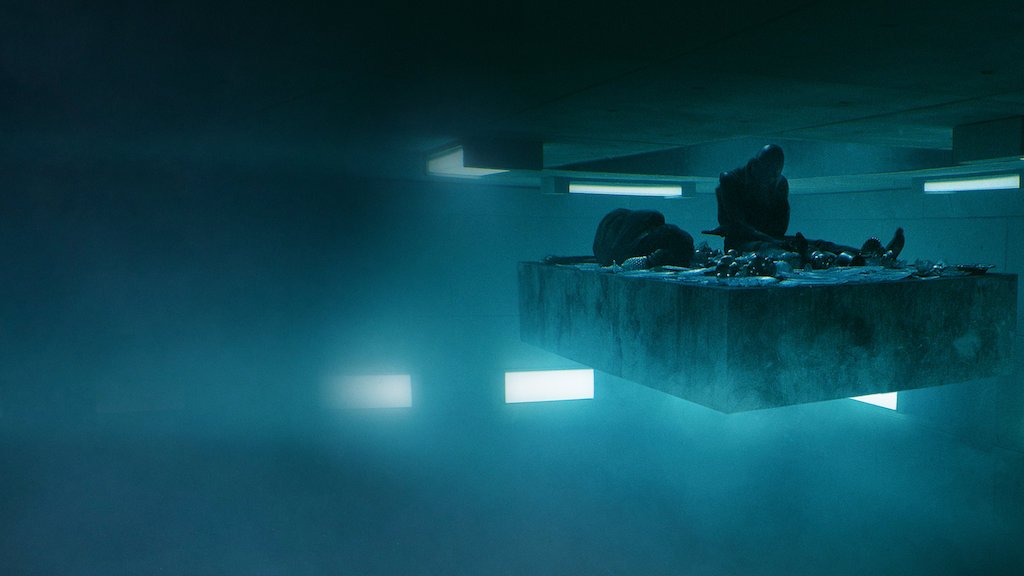Sympathy for the Gimmick: The Platform (2019), directed by Galder Gaztelu-Urrutia by Matt Olsen
Look, obviously, this isn’t a good movie. If I’m defining good as beyond merely entertaining. It’s the kind of movie that you watch because you woke up before you wanted to, can’t get back to sleep, and are resigned to do something extremely non-taxing until it’s appropriate to formally begin the day. The benefit of watching a movie like this in the very early morning is that there still remain a dozen or so hours in which it’s eminently possible to accomplish something (anything) such that, when the day is over, watching The Platform will not be in the forefront of your thoughts. Indeed, it will likely be forgotten. Nothing of any significance was going to happen in those hazy pre-dawn hours, anyway, so nothing was lost. All the above caveats aside, this movie mostly succeeds due to the inexorable power of the gimmick.
It seems like one of these kinds of movies comes out every several years. Typically, not in theaters. A person wakes up in a strange, prison-like environment. They meet an older, wiser character who explains the rules of their new world. Once the exposition has been quickly dispatched, the protagonist navigates the obstructions put in place by their mysterious captors to ultimately achieve freedom. One can find fairly direct comparisons in movies like Cube, Circle, The Belko Experiment, Battle Royale, and, yes, The Matrix. It’s not only a film trope; last year’s hit Netflix series, Squid Game, follows an almost-identical structure. Likewise, it’s not an entirely new phenomenon either as evidenced by such prototypes as The Prisoner, THX 1138, and Logan’s Run.
The gimmick in The Platform is necessarily simple and catchy. Imagine a vertical prison with hundreds of cells stacked on top of each other. In the middle of each cell is a large hole, through which one can see a seemingly endless stretch of identical cells, above and below. Once per day a “platform” of food descends the length of the tower, via the hole, stopping at each cell for only two minutes. In that time, that cell’s prisoners devour whatever has been left by the prisoners above them. The result, of course, is that any poor souls at the bottom wind up with nothing. As a metaphor, it’s not exactly subtle. As a plot device, it’s uncomfortably similar to Snowpiercer. As a gimmick, it’s picture-perfect.
In any sort of high-concept story idea there are a number of why-based questions. In the forefront of them all is why does this work as well as it does? For The Platform (and others like it), I think there are two reasons it’s effective.
First, the gimmick creates a set of boundaries which puts the audience at ease. The hardest and least pleasant part of any game is reading the instructions. Until that’s done, it’s not possible to settle into the main objective: having fun. Once The Platform defines the strictures of its gimmick, the rest is pure amusement. The movie consistently finds new ways to upset the balance while pushing at – but staying within – the parameters agreed upon at the beginning. If a gimmick movie breaks its own rules, it’s over. The audience’s trust is gone.
Second, escaping a byzantine system of unexplained policies and procedures is a fantasy that I assume 99% of people alive today can relate to on a fundamental level. In many of these films, there is at least one character who volunteers to participate in the horror. How this mirrors the way in which any of us choose to participate in our real-world societal structures is a question I’m even more unqualified to answer, especially this early in the morning.
Matt Olsen is a largely unemployed part-time writer and even more part-time commercial actor living once again in Seattle after escaping from Los Angeles like Kurt Russell in that movie about the guy who escapes from Los Angeles.


